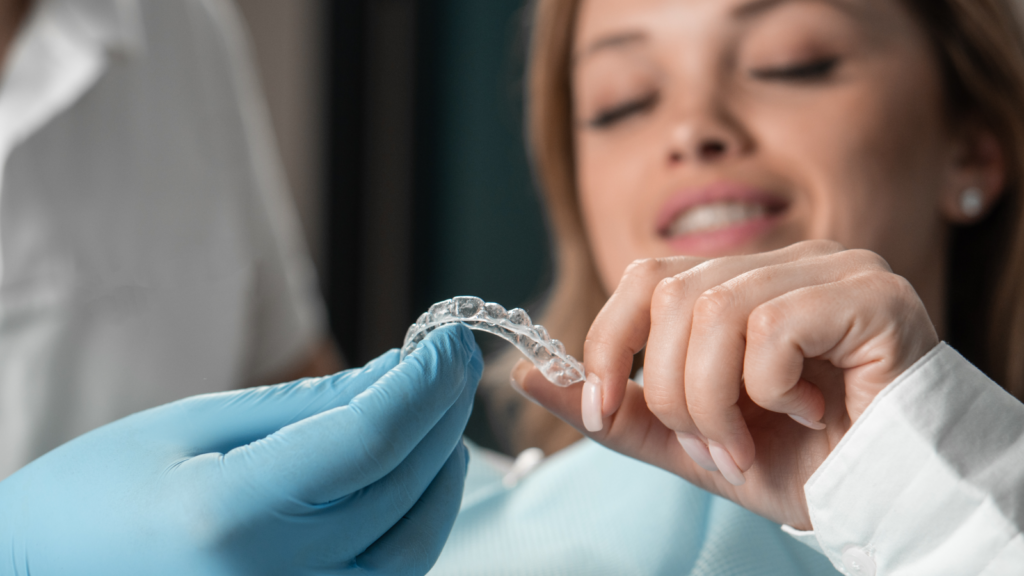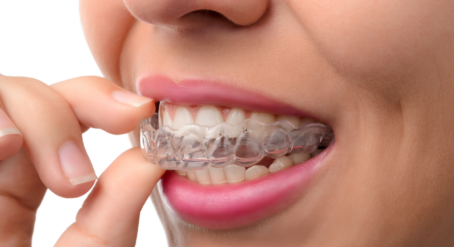We all want a pearly white smile– a nice set of straight, shapely teeth that shine when we smile. But for many people, getting them can require more than a toothbrush and regular flossing.
We’re going to explore the difference between veneers, clear aligners and the three main types of braces. And we’re going to see if any of these products might be right for you, so your smile can go the extra mile.

Veneers
What are dental veneers?
The “quick fix” of the dental world, veneers are thin, white wafers of ceramic or porcelain attached to the outer surface of your teeth. Perfect for chipped, discoloured or ground-down teeth, they can camouflage most minor orthodontic problems without necessarily solving them. While they may help you get the appearance of straight teeth, veneers are a form of cosmetic dentistry applied in your dentist’s office and not an orthodontic treatment.
What are clip-on teeth?
Clip-on teeth, also called clip-on veneers, are for aesthetics only. This type of removable veneer clips into your mouth and sits over your natural teeth to give you the perfect smile. You can get clip-on veneers at your local dentist, and you get to decide the style of tooth and its shade. But like with regular veneers, this is a cosmetic upgrade only – it doesn’t actually fix the problem.
Should you get braces before or after veneers?
Braces are a great way to correct your bite, straighten your teeth and fix any alignment complications before you get your veneers. This can help reduce the likelihood of damage to your veneers in the long-run, give you a better-looking result and make the veneer-applying process smoother. It’s always good to chat to your orthodontist about whether you need braces or not before veneers.
How long should you wait to get veneers after braces or clear aligner treatment?
While you can technically get veneers as soon as your orthodontic treatment is done, it’s always a good idea to wait 3–6 months. This gives your teeth time to settle into their new position and for your gums to heal properly. But if you’re unsure about when to get veneers after orthodontic treatment, talk to your orthodontist.
What are the pros and cons of veneers?
- Pro: Veneers can immediately transform your smile. They’re also great to cover up mildly crooked teeth, or fill in small gaps, as they can be individually coloured and shaped to match with the rest of your teeth.
- Pro: Porcelain veneers are, on the whole are quite resistant to staining. Daily brushing is still essential, of course – but (not being porous like enamel), veneers are less likely than veneer-free teeth to be discoloured by coffee or wine.
- Pro: Putting on the veneers is generally quick. Most veneers can be made and fitted within a couple of weeks.
- Con: Veneers don’t address underlying alignment issues that can occur with crooked teeth, which may lead to uneven wear over time.
- Con: They’re a permanent change. Because attaching them to your teeth involves irreversibly removing some enamel, although you can “take them off” later, you can’t grow the enamel back!
- Con: On top of being a permanent change, veneers are also quite pricey. Any given veneer or porcelain “wafer” tends to cost over $1,000 per tooth, which adds up if you’re tackling multiple teeth. You’ll probably need to replace them at some stage too, which can put a strain on your wallet.
- Con: Since getting a veneer involves losing enamel, your teeth may suddenly become a lot more sensitive to hot and cold foods. This can be quite an unpleasant sensation, but it typically subsides over time.

Braces
What are braces?
A dental standard for over a century, braces straighten crooked teeth or correct misaligned bites, by placing constant pressure on each tooth to move in a certain direction.
While veneers can solve some cosmetic problems, like brown, chipped or broken teeth, braces provide a more natural solution and are designed for more serious “engineering” issues – like overbites, underbites, overcrowding, gaps, general crookedness and can help fix an “incorrectly shaped” jaw with other fixed appliances or techniques.
What’s the difference between metal, ceramic, and lingual braces?
By far the most common type of braces, metal braces tend to involve stainless steel brackets attached to the front teeth, plus some sort of wire or elastic band. They can’t be taken out by hand, and typically need to stay in your mouth for anywhere from 6 months to 2 years.
Also known as “clear braces”, ceramic braces work in the same way as metal ones, but – being made from a more tooth-coloured material – tend to be bit more discreet.
So-called because they’re near the tongue, lingual braces are attached to the inside of the teeth, to be hidden from view. They can be a bit harder to get used to, harder to clean and can affect speech due to your tongue’s placement.
Can you get veneers if you’ve had braces?
Yes you can! Your orthodontist might even recommend veneers as a treatment option after braces if your teeth are discoloured or slightly chipped, or you have small shaped or irregularly shaped teeth. But as we mentioned earlier, it’s always a good idea to let your teeth settle into their new position for a few months before getting veneers.
Can you put braces on veneers?
Yes. While braces may not adhere as well to porcelain as they might to regular enamel, it is entirely possible to fix them onto teeth with veneers. However, it would be recommended that you first undergo orthodontic treatment to straighten your teeth and align your jaws before considering veneers to maintain the integrity of your teeth and gums.

Clear aligners
What are clear aligners?
Closely resembling a very thin plastic mouthguard, clear aligners are a series of transparent trays that work gradually to straighten your teeth. But there are some issues that cannot be fixed easily with only clear aligners. Able to be taken out when you eat, they’re designed to slowly, gently and almost invisibly nudge your teeth into better positions.
Aligners are great for a “touch up” or a very minor fix. Patients need to change to the next aligner as prescribed every one to two weeks. The most important things are how well your aligner treatment is planned out by your orthodontist and that you wear the aligners at least 22 hours a day.
Although more complex cases can be treated by aligners too, the outcome may not be as predictable as using braces. Your specialist orthodontist will be able to determine the best and most predictable treatment option for your individual case.
What is the difference in the cost of veneers, braces and clear aligners?
There is not a fixed service fee for orthodontic treatment in Australia.
This means that prices will vary depending on several factors including the duration of your treatment, the severity of your malocclusion, your treatment type, and your chosen orthodontist’s operating fees.
Average prices in Australia can vary by state, but standard braces treatment may cost anywhere from $6000 – $9000 for a full 18–24-month treatment period.
Whether you’re looking to get metal braces, ceramic braces, lingual braces, or have your heart set on a series of clear aligners, there will be variations in cost depending on which option you go for.
This is due to the cost of the materials and the amount of customisation required.
For example, while metal braces and lingual braces might use similar materials and methodology to straighten your teeth, lingual braces generally need to be custom-made to ensure they fit snugly along the inside of your teeth to limit the impact on your speech.
Standard metal braces, on the other hand, use pre-formed brackets and wires that come in a variety of sizes which the orthodontist then selects and custom fits for each individual patient.
How should you decide whether to get veneers, braces or clear aligners?
The answer to this question will need to come from your orthodontist – but it essentially depends on the nature of the problem that you are trying to solve.
If your teeth “work” fine but could look better, then veneers might be the right move for you. If your teeth are essentially straight, but could perhaps be straighter still or your bite may need some improvement, a clear aligner option may be worth exploring. If your teeth issues are more serious, then more predictable measures may be called for, such as braces.
Before commencing any form of orthodontic or cosmetic dental procedure it is important that you consult a specialist to understand the options that are available to you, as well as any additional risks or considerations.
Use our Finder Tool to search for a specialist orthodontist near you.









